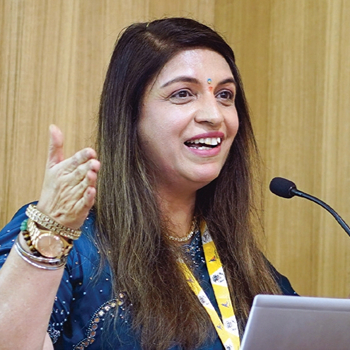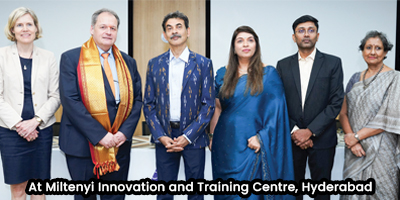Pioneering Healthcare Leadership

With a career spanning almost three decades, Priya Kapoor G Hingorani, MD - India and VP- Southeast Asia (SEA), Miltenyi Biotec, has navigated significant transitions across pharma, biotech and healthcare sectors. She currently drives advancements in precision and personalised medicine across critical markets. Her leadership blueprint for healthcare transformation was shaped through executive roles at GlaxoSmithKline (GSK) and Johnson & Johnson. Her specialty care expertise developed as Head of Neurosciences at Abbott Laboratories, while previous positions at Ranbaxy and Novartis, honed her commercial and operational acumen. Starting her journey with Wockhardt in 1995, she has traversed diverse paths, establishing herself as a key figure in global healthcare. She shares insights with Corporate Citizen, on the sector's evolving dynamics and the future potential of cell and gene therapy
Corporate Citizen: What traits sustained your 27+ years in the sector?
Priya Kapoor G Hingorani: In the dynamic healthcare landscape, adaptability, strategic thinking and execution bias, keeps me ahead. Adaptability is crucial — when responding to regulatory changes, evolving patient needs and integrating emerging technologies like biologics and cell or gene therapies. I focus on translating complex trends into actionable strategies while embracing cross-functional leadership. My experience involves building high-performing teams across geographies, aligning diverse functions from R&D to commercial outcomes around common goals. Leading through change, drives progress consistently. I believe in staying close to the mission. Connecting strategy with patient impact grounds my decisions, enabling initiatives to move with clarity and purpose.
CC: What is the scope of your work?
I lead the company’s innovative portfolio, a science-driven platform focused on delivering patient-centric impact across India and SEA. The company has transformed my career aspirations, allowing me to merge my passion for healthcare innovation with building something truly transformative. My journey represents the potential to fundamentally change lives through science-backed innovation, contributing to a future where advanced cell and gene therapies become standard care for patients who need them the most. The company’s global leadership demonstrates unwavering commitment to cell and gene therapy innovation, providing me with an extraordinary opportunity to contribute to therapeutic areas where treatments remain inadequate or unavailable.
CC: What is the scope of the Hyderabad training centre?
The recently launched Miltenyi Innovation and Training Centre, is designed to train scientists and innovators dedicated to bringing advanced cell and gene therapies to our region. The initiative will introduce innovative treatments while making these therapies more affordable for patients. It’s a once-in-a-lifetime professional opportunity to bring revolutionary therapies closer to patients while building local capacity through education, collaboration, and infrastructure development. Likewise, we are establishing sustainable foundations for long-term therapeutic advancement by developing local expertise and infrastructure, ensuring breakthrough treatments become accessible.
CC: How do you balance profit with patient care ethics?

I have a marketing and sales background, and therefore believe that the most impactful commercial strategies are deeply rooted in patient needs and ethical integrity. In the pharmaceutical and biotech space, we deliver products, but also hope, solutions, and in several cases, life-changing therapies. It bridges the balance between business goals and patient care, making it vital and absolutely non-negotiable. My approach ensures patient-centricity—whether we are developing a go-to-market strategy, engaging with healthcare professionals or entering a new region, I always ask - how does this decision impact the patient? Are we being transparent, ethical and scientifically sound, in what we promise?
CC: What about ethics viz commercial sustainability?
We need strong business outcomes to fund innovation, expand access, and drive long-term impact. The key is to make those outcomes purpose-driven. I believe in ethical practices, transparency, and a deep respect for the patient’s journey, which aren’t constraints, but differentiators. They build long-term trust, amongst customers and across the entire healthcare ecosystem.
CC: How do you align ethics with business success?
Ethical integrity is the cornerstone, bearing strategic advantage for sustained business success. Miltenyi operates in advanced cell and gene therapy, where trust, quality and compliance, are fundamental. Our work aligns with international standards in all aspects of manufacturing, quality management, organisation processes and across the value chain; ensuring product safety, traceability, and robust risk management. In India, we work in accordance with the Central Drugs Standard Control Organisation (CDSCO), Biotechnology Industry Research Assistance Council (BIRAC), and Indian Council of Medical Research (ICMR), Government of India guidelines, for both our biotec and biomedicine portfolio, which we bring for Indian customers and patients.
"I believe in ethical practices, transparency, and a deep respect for the patient’s journey, which aren’t constraints but differentiators. They build longterm trust, amongst customers and across the entire healthcare ecosystem"
— Priya Kapoor G Hingorani
CC: What is the future of cell and gene therapy across SEA?
The future of cell and gene therapy, like with every other market, is likely to follow a regionally nuanced trajectory. We have seen growing interest and investment across countries including Singapore, Malaysia, Thailand, Indonesia and increasingly India, with the growth in healthcare systems and adopting advanced therapeutic modalities. SEA is an emerging hub for our company’s Competitive Generic Therapy (CGT) innovation, particularly in academic research, early-stage clinical development as well as Chimeric Antigen Receptor (CAR)-T cell therapy treatments. The region benefits from a strong base of medical talent, an expanding infrastructure for translational medicine, and government-backed initiatives, accelerating biotechnology.
CC: Has new-age technology impacted the healthcare sector?
Technology has transformed pharmaceutical and biotech industries globally, including India. The Covid demonstrated how technology adoption across R&D, manufacturing, clinical trials, market access, and supply chain management could be streamlined. In cell and gene therapy, innovative platforms like CliniMACS Prodigy® have simplified complex processes, enabling multiple manual steps to occur on a single platform while maintaining Good Manufacturing Practices compliance. Beyond manufacturing, AI and digital tools have revolutionised R&D, quality control, diagnostics, customer engagement, and patient interfaces, significantly improving efficiency and outcomes.
CC: Has digital growth favoured the sector?
Digital growth is transforming healthcare delivery and stakeholder interactions. The AI, ML and LLMs, are revolutionising product discovery and clinical trials while enabling real-time data access. The augmented sales and segmentally targeted marketing, are enabling personalised interactions with healthcare professionals. Mobile apps, digital devices, and integrated platforms, are changing patient engagement and transforming healthcare experiences.
CC: What about digital health infrastructure?
The increasing use of electronic medical records, cloud-based systems, and telehealth has improved healthcare access. Government initiatives like the Ayushman Bharat Digital Mission (ABDM) are pushing the concept forward in a structured way, and companies are aligning our capabilities to support that shift. Technology will continue to help deliver more personalised and targeted treatments, while also improving the speed and reliability of patient access. The challenge and opportunity will ensure that innovations are implemented responsibly, strongly focused on long-term patient safety impacts.
CC: Has digitalisation impacted prescription drug marketing?
Digitalisation has transformed how we communicate with healthcare professionals, from information-pushing to creating meaningful data-backed conversations supporting clinical decisions. We have shifted from one-size-fits-all messaging to a much more targeted (N=1 personalisation), insight-driven omnichannel approaches. In specialised cell and gene therapy domains, we leverage digital tools to deliver complex, relevant, timely and personalised scientific information, tailored to individual Healthcare Professionals' (HCPs) niche expertise and medical specialisations.
CC: Has AI and CRM impacted prescription-based marketing?
The AI-enabled customer relationship management (CRM) systems help us understand engagement patterns, respond to real-time feedback, and adapt content to evolving scientific needs. The tools help us stay agile while respecting clinicians' time and attention. In India, digital platforms are bridging geographic gaps, enabling access to high-quality education and product information in regions that were previously underserved. Virtual detailing, webinars, and modular content libraries have become essential in a rapidly evolving fields and a rapidly changing information environment. Digitalisation is helping us build trust-based stakeholder relationships. It allows us to go beyond product promotion and become true partners in improving patient care.
CC: Will AI and bots replace medical representatives?
Artificial intelligence is reshaping healthcare professional’s engagement through role evolution rather than replacement. In highly regulated, science-led domains like pharmaceuticals and biotechnology, particularly in advanced therapies, medical representatives are becoming more specialised and strategic. AI redefines doctor-rep interactions by handling information delivery through intelligent platforms, while reps evolve into scientific partners and trusted advisors who interpret complex data and deliver contextually relevant insights. AI provides data-driven recommendations, segments audiences with greater precision, anticipating the information needs of healthcare professionals. The AI will become a strong enabler, helping reps to dramatically improve HCP experience with data and innovation.
CC: What is the sector-specific tech intersections?
Technology is revolutionising healthcare through improved diagnostics, telemedicine, genomics, and personalised medicines including CAR-T therapies. Medical students use Virtual Reality and Augmented Reality, robots assist surgeries, and data security gains prominence. Neural networks enable unprecedented innovations. The space is exciting like a sci-fi movie. Our technology leads with CliniMACS Prodigy, UM Blaze 3D modeling, and other advances.
"Digitalisation has transformed how we communicate with healthcare professionals, from information-pushing to creating meaningful data-backed conversations supporting clinical decisions"
CC: Can AI be leveraged for drug discovery and product life cycle management?

Artificial intelligence and data analytics are transforming early-stage drug discovery, patient stratification, and clinical trial design by accelerating timelines, improving target identification, and reducing attrition rates, which makes R&D more responsive and evidence-driven. Our approach builds end-to-end ecosystems from lab to patient, by integrating hardware, software, data and scientific expertise. The opportunity lies in creating and connecting new tools to make breakthrough therapies more accessible, safe and scalable, rather than operating in silos. The opportunity is in creating new tools and threading them together, making breakthrough therapies more accessible, safe and scalable.
CC: How has Indian pharma evolved over the past 20 years?
Over the past two decades, India's pharmaceutical industry evolved from genericsfocused to a global innovation hub for biologics, cell and gene therapies, and personalised medicine. Technology, scientific talent, growing R&D investment and supportive policies, have encouraged global collaboration and indigenous capability building. Public-private partnerships with BIRAC and Department of Biotechnology (DBT) foster innovation, creating robust ecosystems for early-stage biotech organisations.
CC: How does the future look for the industry?
Looking ahead, I see three major trends shaping the future - the rise of personalised medicine, greater digitisation across the value chain, and an intensified focus on sustainable and accessible healthcare solutions. India is uniquely positioned to lead in these areas, and with the right talent and technology investments, the country can emerge as a global leader in manufacturing, as well as biotech innovation, directly impacting patient lives.
CC: What are critical pharma leadership skills?
Leadership in the pharmaceutical industry requires a unique blend of skills, because we are not merely navigating business dynamics, but intersecting the world of science, innovation, regulation and patient care. Strategic agility is a key skill. The industry moves fast, and leaders need to anticipate change; whether it’s scientific breakthroughs, evolving market needs, or shifts in the regulatory landscape. Being able to pivot without losing focus on the longterm vision is essential. Equally important is cross-functional collaboration—no one leads in a silo anymore.
CC: How do you foster innovation and learning?
We are at the forefront of cell and gene therapy; therefore, staying curious, agile, and open to innovation is essential for both scientific progress and team growth. I create psychological safety, empowering teams to ask questions, challenge assumptions, and explore bold ideas without fear. We invest in ongoing development through cross-functional projects, conferences, and internal learning.
CC: What is your advice to young pharma aspirants?
Young professionals seeking successful career in pharmaceutical industry should stay curious, ethical, and patient-focused. The constantly evolving industry demands continuous learning about scientific knowledge, markets, and patient needs.